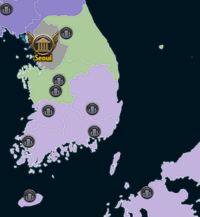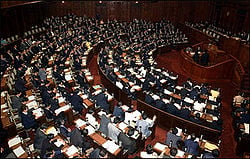War of Lulz
| Languages: | ||||||||||||||||||||||||||||||||||||||||||||||||||||||||||||||||||||||||||||||||||||||||
| ||||||||||||||||||||||||||||||||||||||||||||||||||||||||||||||||||||||||||||||||||||||||
The War of Lulz as the Japanese Invasion of South Korea in May 2010 was known, was an armed conflict between Japan and South Korea. The conflict represented a break in the traditional Japanese - South Korean friendship and was characterized by a propaganda war.
Contents
Background
In May of 2010, Japanese President Danyeo planned an invasion of South Korea. Stated reasons in Congress included a general breakdown in the affairs of the South Korean government, including problems with the National Forums, numerous bogus law proposals, and an inactive government, particularly in the Ministry of Defense. In addition, Danyeo cited South Korea's problems with election fraud and the notorious Carlos Bianchi. Self-proclaimed "Governor General of West Japan," TheReverendSeanV outlined the causes for war in an article "On West Japan," indicating economic and military benefits as well as "Japan needs some excitement." Most analysts speculated that the Japanese military, led by Minister of Defense Dokomo, were bored and really wanted something to do and that this was the main cause, thus the name "War of Lulz." At this time, South Korea had only one alliance active with Malaysia, a minor power.
Shortly before the invasion, South Korean president Peter de LusionisT Bae announced his plan to appoint well-known businessman Alfagrem as Minister of Defense, but the plan was derailed by a pro-Japanese faction who claimed that Malaysia would not honor its alliance with South Korea if Alfagrem was in charge as he was responsible for starting the resistance wars that broke up the Federal Republic of South East Asia (FRoSEA) in late October 2009. Al Dente was therefore installed as Minister of Defense for South Korea.
Japan Declares War
Japanese President Danyeo asked the Imperial Diet to declare war on South Korea shortly after his re-election. The Imperial Diet supported the declaration of war with a 31-8 vote. In response, the Theocrats, former eSouth Koreans who had left the country after abandoning their totalitarian regime, voiced support for South Korea, pledging to defend it. The South Korean government also pledged to defend itself from Japanese aggression. Several prominent Japanese members of congress and private citizens voiced vocal dissent, notably Member of Congress Sophia Forrester, who wrote in her article Patriotic Dissent that the war needlessly ruined the friendship and gave the powerful Theocrats a chance to attack Japan. Japan's military invaded South Korea on May 6th, shortly after the Declaration of War proposal passed congress.
Opening of the war
Formal hostilities commenced on May 6th when Japan launched an attack on Gyeongsangbuk-do. The initial battle was a brutal engagement, much more difficult than the Japanese had anticipated--after the first 15 hours of Japanese success, the South Koreans pushed back, and it looked as if their lines would hold. The Japanese victory was secured only in the final moments of the battle, when jankems and other USA tanks intervened after receiving gold from the Japanese Treasury. Some Japanese citizens, including Origineel.NL, a long-time Japanese citizen, chose to fight on the side of the defenders. Most, however, were former Koreans (North and South) who had temporarily taken Japanese citizenship in the past.
The lull in fighting
After the close defeat at Gyeongsangbuk-do, the South Koreans paid the costs for an alliance with Germany in an attempt to shore up its defenses. The alliance barely passed the German Parliament, however, succeeding by only one vote. During the next week, from May 7 until May 13, little happened as both sides considered what to do next. Prominent South Korean Arjay Phoenician wrote an article TheReverendSeanV: The War is Over taunting TheReverendSeanV after apparently receiving a private communication from him that claimed that the war was over now that South Korea had an alliance with Germany and Malaysia.
The Whirlwind Attack
On May 13th, Alfagrem again launched a resistance war, this time in Gyeongsangbuk-do, timed to coincide with the end of the Malaysia alliance term and delay the Japanese advance. The JIA put down the resistance, and two days later on May 15th, simultaneously attacked Chungcheongbuk-do, Chungcheongnam-do, and Gyeongsangnam-do. With the help of Croatian allies, the JIA easily won all three battles, pushing into South Korea despite determined resistance from both South Koreans and other allied troops. Confusion on the South Korean side and a lack of regular weapons distribution from the government hindered the defense. Alfagrem started two more resistance wars, in Jeju as well as Gyeongsangbukdo, which was again put down easily as there were few resistance fighters. May 16th opened with a two-pronged attack, a distraction force in Jeollanam-do and the main element assaulting Gyeonggi-do, both battles ending in victory for Japan. After the fall of Seoul in Gyeonggi-do, South Korea's only Q5 hospital was destroyed. Fighters distinguishing themselves as the top fighters for their countries in two or more of these battles included Anon Bliss and KITA Ikki on the Japanese side and Alfagrem and Eisenhorn on the South Korean side. A more detailed after-action review can be found in the article The War Winds Down.
Eye of the Storm
After conquering South Korea's major population centers, prominent Japanese politicians offered the South Korean community a chance to stay in their homes and receive the same benefits under Japanese government as they had under South Korean independent government. Japanese president Danyeo proposed construction of a Q5 hospital as well as a Q5 Defense System, which congress approved. Although the Hospital proposal passed 30-3, the Defense System proposal the next day narrowly passed, 17-16, as Danyeo instructed members of congress to vote against it after realizing they would be difficult to defend without the consent of the South Korean community.
The victory in Seoul was to end any illusions the South Koreans had about Japanese intentions and the abject failure of the MoD Al Dente and the group surrounding him in forming any coherent resistance was to result in the rising to prominence of Joseph Orair who reorganized the eSKers in the remaining 2 regions and also the return to service of Alfagrem who would lead those operating behind Japanese lines.
Russia Joins The Fight
South Korean resistance fighters launched two resistance movements on May 21st, one in Jeollanam-do and one in Chungcheongbuk-do, winning with the help of Russian and Portugese tanks. On May 22nd and May 23rd, resistance wars broke out in Gyeongsangbuk-do, Gyeongsangnam-do, Jeju, Gyeonggi-do, and Chungcheongnam-do, although only the movements Gyeongsangbuk-do and Gyeonggi-do were successful. The fighting in Gyeonggi-do resulted in the destruction of the newly deployed Q5 hospital and Q5 Defense System, making them the shortest-lived Q5 constructions in New World history, having lasted less than 72 hours. Jeju, Gyeongsangnam-do, and Chungcheongnam-do were all freed by resistance movements on May 25th, restoring South Korea to its pre-war borders as well as taking back Jeju islands from the Japanese who had held them for well over a year. For the first time since early 2009, Japan controlled no territory outside of its home regions. South Korean propagandist Arjay Phoenician described the defeat in his article "Six Tanks and Nowe Make the Difference," celebrating the resistance victory in Gyeonggi-do and once again accusing Japan's new leadership, Danyeo, Dokomo, and TheReverendSeanV of abandoning the Righteous Nation image for the sake of wars of amusement."
Aftermath
At the end of active hostilities, Japan's position was weaker than before, now in possession of no regions outside of its homelands and much poorer after the quick destruction of two valuable constructions and other significant wartime expenditures. South Korea's leadership had changed, with South Korean President naming Al Dente as the next Minister of Defense, as well as signing an alliance with Russia. Observers wondered if this meant that South Korea was a de facto member of the Phoenix alliance, and indeed shortly after the hostilities ended, South Korea President Peter de LusionisT Bae allowed Russia and Russian-controlled North Korea to make region exchanges with South Korea, including Seoul and Gyeonggi-do, in preparation for an advance against China.
Battles fought
| Date Started | Region | Victor | Number |
|---|---|---|---|
| 06 May 2010 | Gyeongsangbuk-do | |
10337 |
| 07 May 2010 | Jeju^ | |
10344 |
| 13 May 2010 | Gyeongsangbuk-do^ | |
10396 |
| 15 May 2010 | Chungcheongbuk-do | |
10425 |
| 15 May 2010 | Chungcheongnam-do | |
10426 |
| 15 May 2010 | Gyeongsangnam-do | |
10427 |
| 16 May 2010 | Jeju^ | |
10428 |
| 16 May 2010 | Gyeongsangbuk-do^ | |
10429 |
| 16 May 2010 | Jeollanam-do | |
10442 |
| 16 May 2010 | Gyeonggi-do | |
10441 |
| 19 May 2010 | Jeollanam-do^ | |
10487 |
| 21 May 2010 | Jeollanam-do^ | |
10535 |
| 21 May 2010 | Chungcheongbuk-do^ | |
10543 |
| 22 May 2010 | Gyeongsangbuk-do^ | |
10565 |
| 23 May 2010 | Gyeongsangnam-do^ | |
10566 |
| 23 May 2010 | Jeju^ | |
10567 |
| 23 May 2010 | Gyeonggi-do^ | |
10568 |
| 23 May 2010 | Chungcheongnam-do^ | |
10569 |
| 24 May 2010 | Jeju^ | |
10589 |
| 24 May 2010 | Gyeongsangnam-do^ | |
10590 |
| 24 May 2010 | Chungcheongnam-do^ | |
10591 |
^ indicates Resistance War in occupied region
Links:
See also
- Second Japan-South Korea War, same events as told from South Korean perspective




